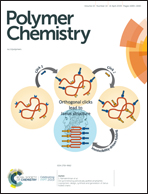Copolymerization of (meth)acrylates with vinyl aromatic macromonomers: understanding the mechanism of retardation on the kinetics with acrylates†
Abstract
The polymerization of n-butyl acrylate (BA) and n-butyl methacrylate (BMA) in the presence of different amounts of a macromonomer containing vinyl aromatic terminal double bonds presents completely different behaviors. While the polymerization rate of BMA is not affected by increasing amounts of the macromonomer in the formulation (up to 40 wt%), the polymerization of BA is strongly affected; the polymerization rate decreases as the concentration of the macromonomer increases. Quantum chemical simulations of the potential reaction mechanisms for both monomer systems revealed that for BA the tertiary radical formed by the addition of a tertiary BA radical (most predominant compared to the secondary radical) to the macromonomer double bond is very stable, hence this reaction acts as a radical sink that reduces growing radicals’ concentration and polymerization rate. Furthermore, a mathematical model of the polymerization process considering the most likely mechanisms evaluated by the quantum chemical simulations was able to fit reasonably well the polymerization of the two monomers. Guidelines for the values of the unknown kinetic rate coefficients are obtained.



 Please wait while we load your content...
Please wait while we load your content...